#grunty'sgoodbye
Explore tagged Tumblr posts
Photo

Grunty’s Goodbye: ‘83 Custom Corvette Convertible
What do you do when possibly a fan favorite retires? Well, you may be a little disappointed, but you say “goodbye” regardless. This is exactly what happens in this scenario. On today’s installment of Grunty’s Goodbye, we take a look back at the ‘83 Custom Corvette Convertible... and talk about it.

Designed by Jerry Palmer under Dave McLellan’s supervision, the C4 Corvette was produced from 1983 to 1996. Representing a clean break from the C3 designed by Zora Arkus-Duntov, the bumpers were made from molding plastics and was also the first Corvette to have a glass hatchback. Engines from the L89 to the LT1 V8 were available, all in 350 ci (5.7L). The last C4 Corvette rolled off the production line on 20 June 1996.
Now that we’ve gotten all that out of the way let’s talk about the reason why you’re here; the history of the Custom Corvette Convertible.

The Custom Corvette Convertible was originally introduced in 1989 in this paintscheme in the Speed Fleet series, along such cars like the ‘80s Corvette and Ferrari F40. Designed by Larry Wood, this casting depicted a C4 Corvette Convertible, but with flared fenders and a lower front bumper.

An interesting detail is the license plate; it reads “ZR-1��.

The base reads “83’ CUSTOM CORVETTE” (sic); it appears to have been changed to “CORVETTE STINGRAY” at some point.

Another base variation exists, where “CUSTOM CORVETTE” is written instead.

Other notable releases included the California Customs series with the extremely unique TWs (Turbo Wheels) only used for this series...

The car from the Revealers series...

From the Corvette 5-Pack...

A cereal promo...

And even in gold chrome to celebrate the one billionth Hot Wheels car. However, all good things must come to an end, and the same applies in this case, because in 1999, this casting was thrown into the Final Run Series.

The Final Run Series started in 1999 and acted as what I would consider a very glorified funeral for a casting; Hot Wheels would give these cars special tires and paint, in exchange for vowing to never produce them again by cutting their toolings in half. The Corvette was unfortunately one of the castings to fall victim to the Final Run Series, and even though it was one of the more popular castings at the time, it was still retired regardless. As the first batch of cars to be Final Run, having been introduced in the 1999 series, the Wildcat will never be seen again in the Hot Wheels lineup unless a new tool and die is created for it, which I believe is highly unlikely. The Final Run Series itself has been on hiatus since 2006. In total, the Custom Corvette Convertible had forty releases.

Fitted with a highly detailed rear and a Pro Circuit 6-spokes, this was a fine sendoff for a casting that would never be seen again... except it was.

Because sometime in 2000, a mysterious release of the Custom Corvette Convertible appeared in Mexico; this release has had no context whatsoever and was essentially identical to the 1998 Tropicool release, sans tampos.

Any wording on the card was also mysteriously absent.

This variant is still being researched on. And here is the original Tropicool version just for comparison. That mysterious release was the true last release of the Custom Corvette Convertible.

Because of its flat sides with loads of space, the Corvette Convertible was the recipient of lots of graphics. It’s a shame that this casting had to be retired, because I kind of want a C4 Corvette Convertible to return to the mainline.

I hope this has given you a better idea of the history of the Hot Wheels Custom Corvette Convertible. As usual, I’d do it again any day.
- Grunty
2 notes
·
View notes
Photo
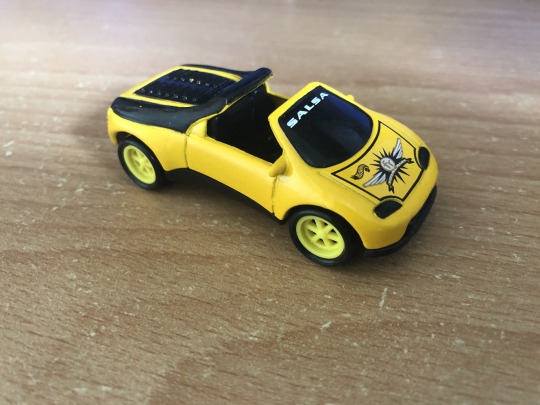
That Time Forgot: Pontiac Salsa
A car named after a sauce? Cute. But as usual, this was an actual concept car designed by GM. Want to know more? Let’s talk about it in today’s installment of That Time Forgot.
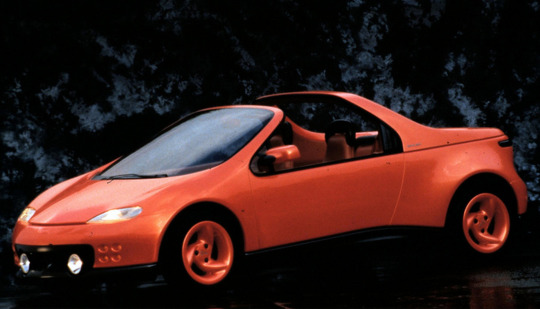
Conceived by GM’s Advanced Concept Center based in California, the Salsa was meant to be “an athletic small vehicle with modular parts”. We’ll get to that part later. The car was introduced at the 1992 Chicago Motor Show.

This small two-seat convertible with flowing three-spoke wheels was engineered to be as modular of a car as possible. In its standard configuration, the car was presented as shown above; however, it has a removable top and a removable rear end piece situated above the rollbar.

One module of the Salsa could be switched in to turn the car into a five-seat convertible.

The rear seats could then be folded forward to make this car a small pickup.

Another module was available which could turn the car into a small panel van.

Yet another module was available which could turn the car into a five-seat hatchback.

The interior of the car looked rather basic for the time, with a simple analog dashboard and a manual transmission. Any details about the powertrain or underpinnings of the car are unknown.

Advertisements involving the Salsa touted its modularity, but ultimately, the Salsa never came to be. Two cars were produced; presumably they are sitting amongst a sea of other cars at the GM Heritage Center, while the concept of modularity lives on today, predominantly in SUVs. The Salsa has been seen out of the collection a few times since, but it seems to have its unique three-spoke rims changed out.
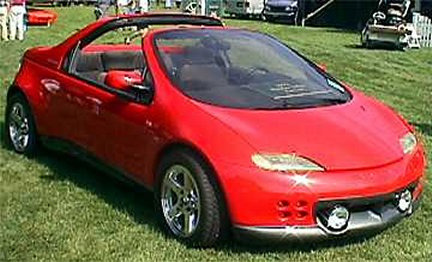
Now that we’ve gotten all the history of this thing out of the way, let’s talk about the reason why you’re here: the Hot Wheels version of the Salsa.
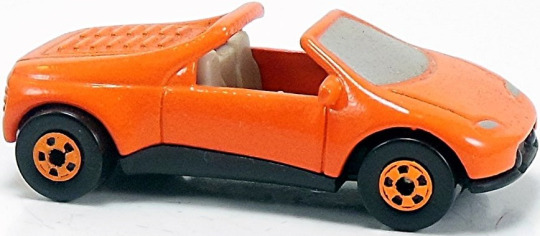
This casting was introduced in 1993 in the Demolition Man series, alongside eight other cars that appeared in the movie: these were the Oldsmobile Aurora, Olds 442 W-30, GM Ultralite, GM Lean Machine, Corvette Stingray III, Pontiac Banshee, Buick Wildcat and the Chevrolet ACC Camaro (’93 Camaro), intended to represent the Chevrolet California IROC Camaro Concept. The designer of this casting is not known with any certainty, although I suspect it was done by Larry Wood.
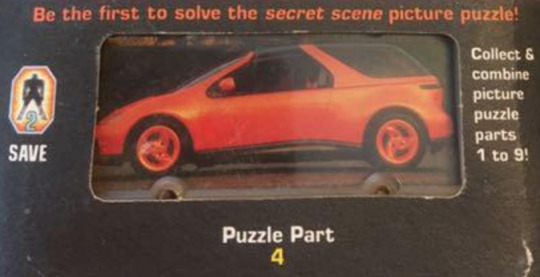
Something rather interesting is that despite the Salsa being in this series, the car apparently is not featured in the movie, unlike the other eight cars.

While a nice little casting, I have two minor gripes about the Salsa; these involve the windscreen and the rear. First off, the windscreen is another slab of metal which can’t be seen through, but I guess whatever works works.

The second gripe I have is with the rear, with the taillamp position resembling nothing like the real thing, but maybe this was something to do with a much earlier prototype.

I couldn’t find any colored images of the rear of the Salsa convertible, so this one will have to do. Compare it to the rear of the Hot Wheels model and you’ll see what I mean.
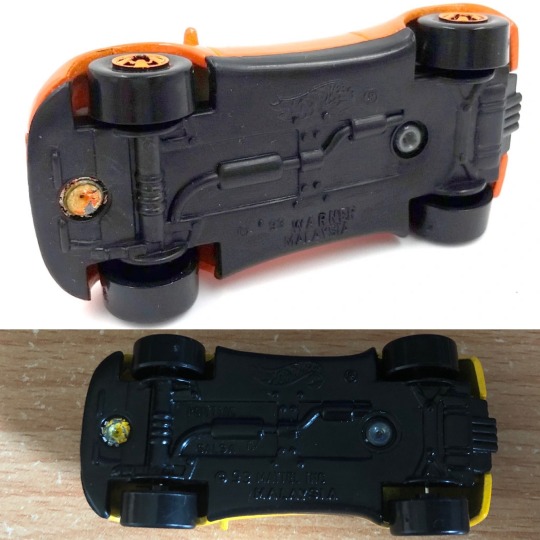
This casting has a plastic base, although it seems at least one of the versions has a metal base. Early versions will say "'93 WARNER” instead of “93 MATTEL INC” and “PONTIAC SALSA”; I presume the license with Warner Bros. had expired, so they just scrubbed off the Warner licensing information and put their own on.

The casting itself did not enjoy the frequent releases its other castmates had in the Demolition Man Series, but ultimately this casting was doomed in 1999 for one reason, and one reason only: the Final Run Series.

The Final Run Series started in 1999 and acted as what I would consider a very glorified funeral for a casting; Hot Wheels would give these cars special tires and paint, in exchange for vowing to never produce them again by cutting their toolings in half. The Salsa was unfortunately one of the castings to fall victim to the Final Run Series, and although it might not have been one of the more popular castings to retire that year, it was still retired regardless. As the first batch of cars to be Final Run, having been introduced in the 1999 series, the Salsa will never be seen again in the Hot Wheels lineup unless a new tool and die is created for it, which I believe is highly unlikely. The Final Run Series itself has been on hiatus since 2006. In total, the Salsa had nine releases.

I hope this post has given you a better idea on the history of this small but modular American convertible, and the history of its small Hot Wheels counterpart. As usual, I’d write something like this any day.
2 notes
·
View notes
Photo
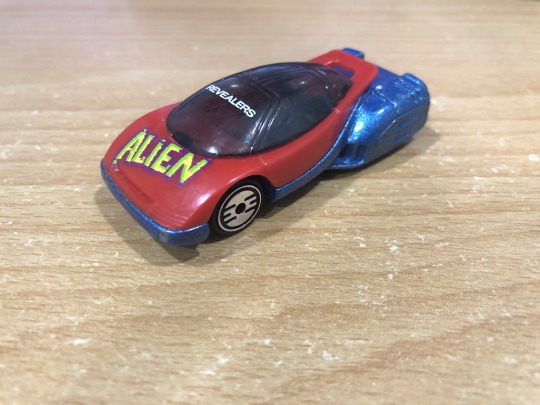
That Time Forgot: IAD Alien (and related concepts)
I gotta admit. For the longest time, I thought that this car, with its supremely space-age design, was not real. But after a bit of a search and some other things... I found it was. I believe some people might share this sentiment. Today, I’m going to talk about the history behind the IAD Alien, along with, as a bonus, all of the other things IAD made over the years.

IAD, or International Automotive Design, was a British design company founded in 1976 by husband and wife Yvonne and John Shute. The company originally designed bodies for trains (my other interest), but eventually branched out to designing bodies for automobiles. Increasing demand eventually caused IAD to branch out to encompassing various different facets of the industry, from design and sculpting models to small-scale production. In the 1980s, IAD was one of the biggest automotive design firms in the world, competing against such giants like Bertone, Italdesign and of course, Pininfarina, and also had multiple facilities around the world.
Touted as “Britain’s Largest Styling Company”, IAD meant business. To prove that they were a force in the industry, they designed a number of concept cars throughout the 1980s to early 1990s, and we’ll be talking about them here. I will not be counting cars that were designed by IAD, but manufactured by another company.
The first of the concept cars they designed was known as the TRX.

The TRX was a radical restyling of the Triumph TR7, designed by Martin Longmore. The TRX attempted to make the car have a completely different appearance, but keeping the fundamental structure of the car as close as possible to the TR7. General Electric Plastics helped to fund the project. It was displayed at the 1980 Birmingham Motor Show.
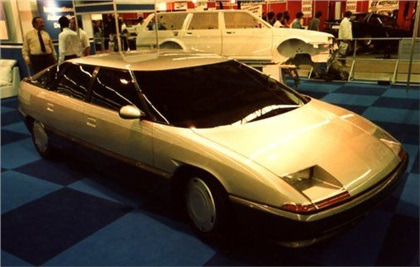
Their next project was the Arrival, displayed at the 1985 Frankfurt Motor Show. The car attempted to demonstrate IAD’s expertise with computer-aided design, showing a proposal for a five-door sedan designed entirely with a computer.

The next car IAD would design would turn out to be arguably their most famous design yet, helped by the fact that a Hot Wheels model was produced replicating the car: the Alien.

The IAD Alien was designed by Longmore and Marcus Hotblack, and was their proposal for a futuristic mid-engined supercar. Featuring a canopy door which tilted forward for unhindered entrance and egress, the Alien showcased a number of interesting solutions for the general public. The car was first introduced at the 1986 Turin Motor Show.

The car itself featured a highly sophisticated interior with a starship-like steering wheel and heads-up display for the dashboard. The interior was also well-protected, with an integrated roll cage in the car. Quite possibly the most interesting part of the car was its modularity; owners of the car could switch out engines on the fly for easy upgrading, maintenance or to change to something else the driver suited. A bit over the top, yes, but that’s what the ‘80s were like.

Unfortunately, the car was non-functional, and Longmore and Hotblack would move on to their next project.
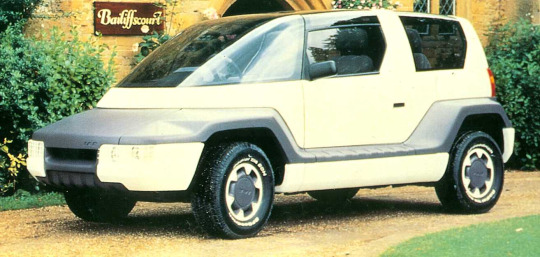
The Impact was their next project, also designed by Longmore and Hotblack. Built on a Ford Sierra chassis and powered by a 2.8L Cologne V6, the Impact aimed to be one of the most barrier-free SUVs possible, with folding steps when any of the doors opened. A split tailgate and underfloor storage allowed the Impact to store more than a usual SUV could. It was branded as a Sports/Utility Car by a brochure, and featured an in-car navigation system. The car was showcased at the 1987 Frankfurt Motor Show.
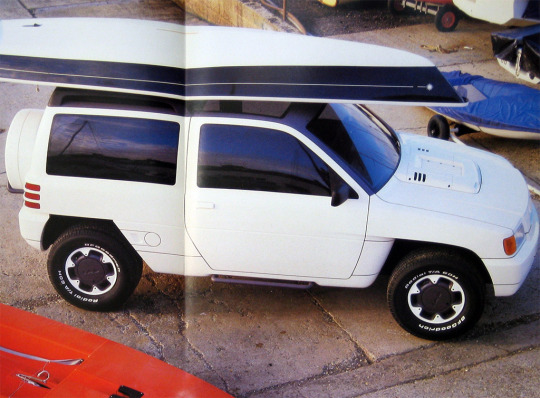
To add to their SUV portfolio, IAD did up the Interstate. Designed by Tony Pettman, the usual Ford Cologne V6 was fitted underneath a soundproof cover, allowing for some of the quietest rides. It too, like the Impact, was introduced at the 1987 Frankfurt Motor Show.

Following up the Impact was the Hunter, a rugged off-road vehicle equipped with navigational systems and a telephone. Appearing very similarly to the Impact, the Hunter was also fitted with the same Ford Cologne V6 and featured weatherproof seats made out of foam. It was showcased at the 1988 Turin Motor Show, and was designed by Longmore, Hotblack and Dave Ancona.

After the Hunter came the Royale, designed by Bill Barranco and Jose Diaz de la Vega. The Royale was built around a highly modified Subaru XT-6, with the wheelbase stretched. Meant for business executives, the Royale had a rotary keypad and controls for the CD player and satnav systems available to both rear passengers. The headlights and taillights were engineered by Phillips (yes, that Phillips), and featured a massive LED screen in the rear of the car integrated with the taillamps engineered to give various pieces of road safety information. It, like the Hunter, was also shown off at the 1988 Turin Auto Show.

Their next car was the rather interesting-looking (and potentially rather unsightly) Venus. Introduced at the 1989 Tokyo Motor Show, the Venus was designed by Michael Ani and touted as a futuristic supercar with both performance and a distinctive appearance. The design aimed to form a blend between the technical and aesthetic aspects of the car. A functioning model of the car was eventually built on a Lotus Elise chassis.

Their next project was simply titled the Mini MPV. Powered by a Ford Escort’s CVH 1.9L engine, the Mini MPV could seat six people in three rows. It debuted at the 1990 Turin Motor Show and may have been trialed at Los Angeles International Airport at the time.

Okay, I’m breaking the “outsourced production” rule, but technically this thing was designed by IAD but never produced, so it sort of qualifies. This is the IAD Magia (or Lancia Magia), designed by Ani and Brian Osborn. Featuring the 2.0L FIAT Twin-Cam inline-4 from a Lancia Delta Integrale, the Magia featured a “svelte body” on top of a Lancia Dedra platform, and was touted as “a car to capture the imagination of all the devotees of sporting coupes”. The car was shown off at the 1992 Turin Auto Show, where it was extremely well received, although serial production never materialized.
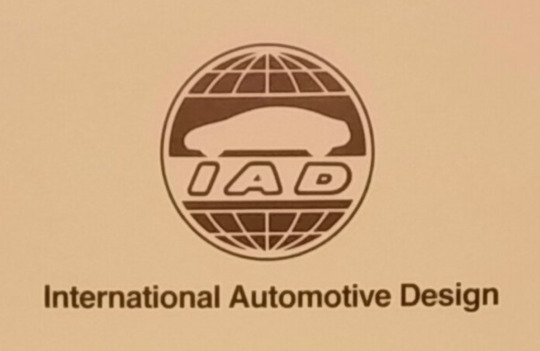
Reeling from the effects of the European Union’s automobile industry’s worst recession, IAD went into receivership and was acquired by Mayflower Group in 1993. John Shute would die two years later on 13 January 1995, aged 54. Despite his death, IAD would go on to design one more concept on their own.

That design was the EuroTaxi. This was a taxi designed to be the cheapest and most efficient taxi to operate by miles. The EuroTaxi attempted to extend service intervals through the use of both an internal combustion engine and an onboard battery pack, and as a result, decrease downtime. The car was showcased at the 1995 Frankfurt Motor Show, but of course, no orders were placed. The EuroTaxi would turn out to be IAD’s last design.

With the money running dry due to said recession, Britain’s Leading Styling Company were forced to release their chokehold on the car design industry and vanished. The company’s design facilities were bought over by Daewoo Motors, and IAD faded into obscurity, never to be heard from again, while Pinifarina, Bertone and Italdesign are still around today, designing cars.
Okay, now that we’ve gotten the history of IAD out of the way, let’s talk about what you came for: the Hot Wheels version of the IAD Alien.

The Alien was designed by Larry Wood and first introduced in the 1989 Speed Fleet series in the above color, somewhat replicating that of the real Alien; however, this color is quite rare and was quickly replaced by the far more common red version. The casting never received any mention of IAD on it; for all its releases it was simply titled “Alien”.

The Alien features a plastic wraparound body rivited to the base, with metal fender flares and a plastic canopy. This canopy can theoretically be removed, but I’m not going to attempt to do so; instead, I’ll show a picture of one with the canopy removed.

The casting has a metal base, which makes this casting quite heavy. It actually has some decent details on the undercarriage.

The base features few markings apart from the logo and copyright information. I can honestly see people not being able to identify this car, but this was at a time where little other information other than copyright and the Hot Wheels logo was placed on the base; this lasted from about the mid-’80s to the mid-to-late-’90s, at which point it was presumably mandated to put the name of the casting on the base unless it couldn’t fit.
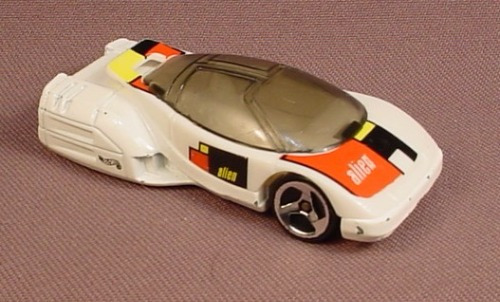
The Alien enjoyed the privilege of being released quite often when it was in the lineup, but ultimately this casting was doomed in 1999 for one reason, and one reason only: the Final Run Series.

The Final Run Series started in 1999 and acted as what I would consider a very glorified funeral for a casting; Hot Wheels would give these cars special tires and paint, in exchange for vowing to never produce them again by cutting their toolings in half. The Alien was unfortunately one of the castings to fall victim to the Final Run Series, and although it might not have been one of the more popular castings to retire that year, it was still retired regardless. As the first batch of cars to be Final Run, having been introduced in the 1999 series, the Alien will never be seen again in the Hot Wheels lineup unless a new tool and die is created for it, which I believe is highly unlikely. The Final Run Series itself has been on hiatus since 2006. In total, the Alien had fifteen releases.

Always on the receiving end of very loud decals due to its plastic sides and large fenders, the Alien will be dearly missed (by me, at least) in the Hot Wheels lineup, and I wouldn’t mind seeing a modern recreation of the Alien return to the Hot Wheels lineup as a premium piece.
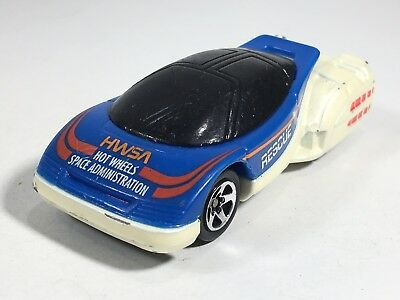
I hope this post has given you a better idea on the history of this futuristic British supercar concept, and the history of its small Hot Wheels counterpart. As usual, I’d write something like this any day.
- Grunty
3 notes
·
View notes
Photo

That Time Forgot: Buick Wildcat
Okay, who would have thought that there was a possibility for you to say “Buick” and “McLaren” in the same sentence? Well, this is quite possibly the only time you can do that. Today, let’s talk a bit about the nameplate’s history... as well as the casting, in today’s installment of That Time Forgot.

Before we talk about the Wildcat in question, let’s go back in time to 1953, when the first Wildcat was introduced.
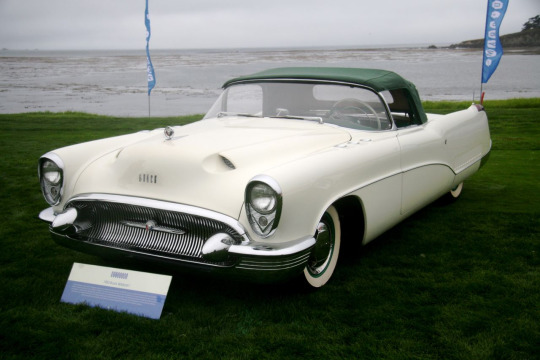
Enter the 1953 Buick Wildcat, internally known as the Wildcat I. Designed under the direction of GM head of design Harley Earl, the Wildcat was designed for the sole purpose to see if it was feasible to put a fiberglass bodyshell on top of a car. The car was powered by a 322 ci (5.3L) Nailhead V8 producing 188 horsepower. With a wraparound windshield with a 60° slope, the Wildcat successfully influenced the design for Buick’s 1954 cars. After its tour of the auto show circuit complete, the Wildcat was sentenced to the scrapper, but was saved and is now in the hands of Joe Bortz.
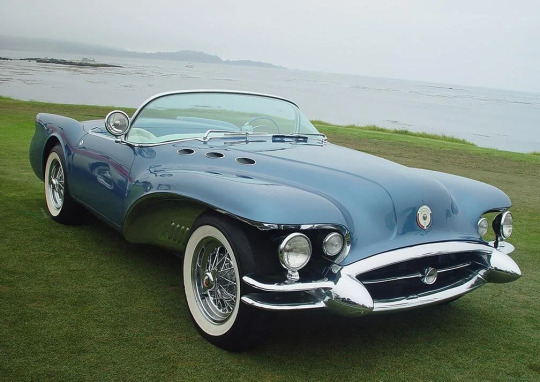
1954 came another Wildcat, internally dubbed the Wildcat II. Also designed under the direction of Earl, this Wildcat was a styling exercise, combining modern elements with classic styling from years gone past; it was because of this that Buick billed the Wildcat as an “American Adventure in Tomorrow's Design”. The car was powered by a 322 ci (5.3L) Buick Nailhead V8, producing 220 horsepower, and was specifically made to be fully functional (like the Wildcat I) in the event that GM chief Harlow Curtice wanted one for his own.
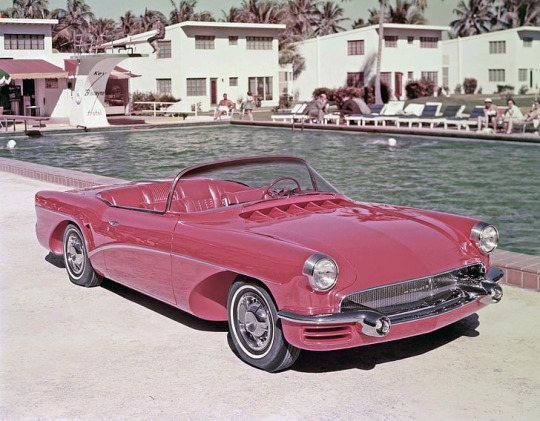
In 1955, another Wildcat came, internally designated... guess what. Also designed by Earl, the Wildcat III was probably the most conservative of the three 1950s Wildcat concepts, although it was quite a bit larger and longer than the previous two Wildcats. Powered by the same 322 ci (5.3L) Buick Nailhead V8 as the previous two Wildcats, the Wildcat III’s V8 was boosted to 280 horsepower with the help of a quad-carburetor setup. Nicknamed the “Toy Convertible”, the Wildcat featured a Twin Turbine Dynaflow 2-speed automatic transmission and featured rear seats, allowing for four passengers. After its tour of the auto show circuit was over, the Wildcat III was ordered to be junked; however, nobody really knows for sure what happened to it.
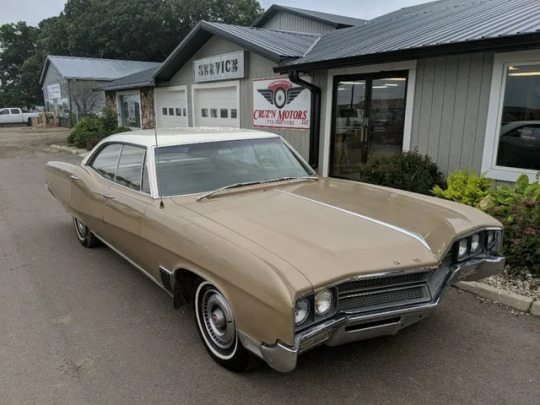
The Wildcat name was subsequently used for a number of full-sized automobiles produced by Buick from 1963 to 1970, but that’s not what you’re here for. Instead, you’re here for this: the 1985 Buick Wildcat.
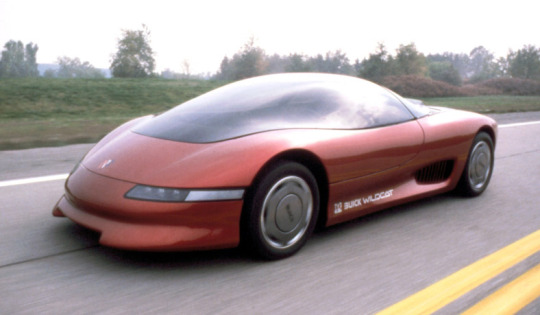
Some fifteen or so years after production of the Wildcat had halted, Buick came out with another Wildcat. This was a futuristic sports car featuring swoopy lines and a canopy which tilted forward for entrance and exit.
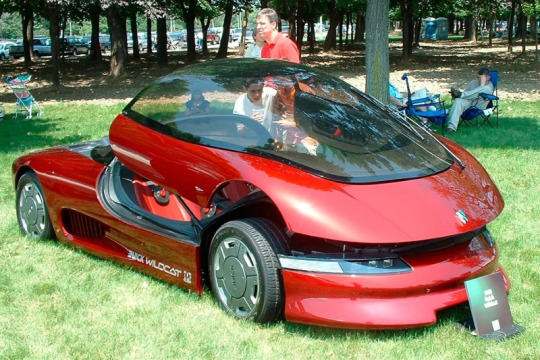
Two prototypes were produced; one non-running one that was showcased at SEMA in 1985, and one fully-functional prototype. The running prototype was powered by an experimental 3.8L Buick V6 built by McLaren Engines (no relation to the British car company).
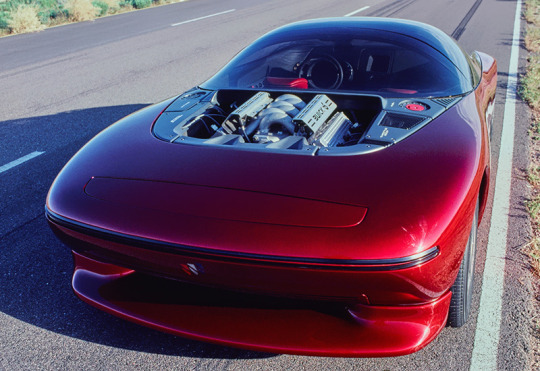
This exposed engine generated some 360 horsepower at 7,000 rpm and 398 lbf⋅ft (540 Nm) of torque. However, given the hardware this thing ran on, performance for the Wildcat... wasn’t that spectacular, with 0-60 mph (0-96 km/h) taking 8.6 seconds. The top speed for the Wildcat was actually electronically restricted to 70 mph (112 km/h); top speed figures for an unrestricted Wildcat remain unknown.

The body was made of fiberglass and carbon fiber, and the car featured a 4-speed transmission which could be manually shifted.
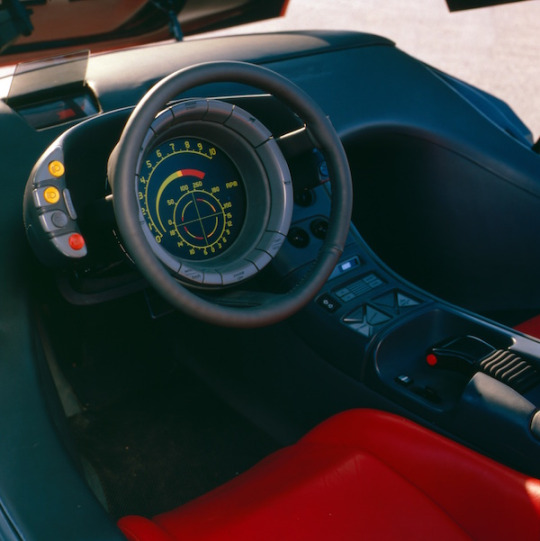
The interior of the Wildcat was highly advanced for its time, with a screen in the middle of the steering wheel display information such as G-force, torque, oil pressure and a compass. To add to that, a heads-up display was also added, displaying speed, mileage and gear selection on the glass canopy.
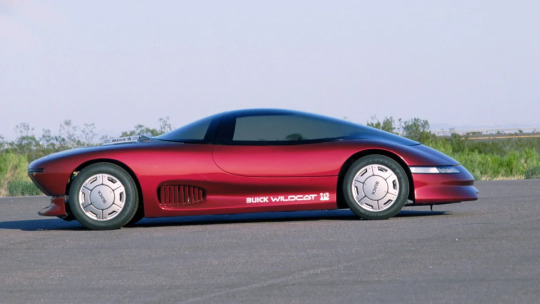
Despite all the high-tech features, all the Wildcats remained prototypes, and they now sit among a sea of other cars at the GM Heritage Center, with the exception of the Wildcat III (which isn’t there).

The Wildcat got its big break in the film industry when it appeared briefly in a scene in the 1993 film Demolition Man alongside some seventeen other GM concepts.
Okay, now that we’ve gotten all of this info out of the way, let’s get to the real reason why you’re here.

This casting was introduced in 1993 in the Demolition Man series, alongside eight other cars that appeared in the movie: these were the Oldsmobile Aurora, Olds 442 W-30, GM Ultralite, GM Lean Machine, Corvette Stingray III, Pontiac Salsa, Pontiac Banshee and the Chevrolet ACC Camaro (’93 Camaro), intended to represent the Chevrolet California IROC Camaro Concept. This casting was designed by Larry Wood. Something notable about the Wildcat was the “canopy” piece, which was simply the car’s body painted black.
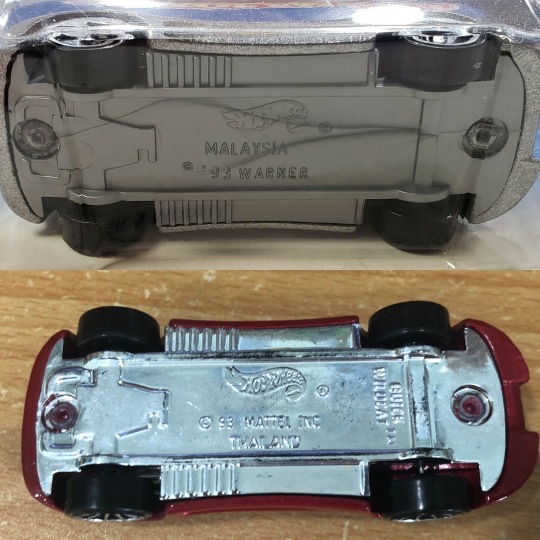
This casting has a metal base and plastic body. Early versions will say "'93 WARNER” instead of “'93 MATTEL INC” and “BUICK WILDCAT”; I presume the license with Warner Bros. had expired, so they just scrubbed off the Warner licensing information and put their own on.

The Wildcat enjoyed the privilege of being released quite often when it was in the lineup, but ultimately this casting was doomed in 2005 for one reason, and one reason only: the Final Run Series.

The Final Run Series started in 1999 and acted as what I would consider a very glorified funeral for a casting; Hot Wheels would give these cars special tires and paint, in exchange for vowing to never produce them again by cutting their toolings in half. The Wildcat was unfortunately one of the castings to fall victim to the Final Run Series, and although it might not have been one of the more popular castings to retire that year, it was still retired regardless. As the final batch of cars to be Final Run, having been introduced in the 2005 series, the Wildcat will never be seen again in the Hot Wheels lineup unless a new tool and die is created for it, which I believe is highly unlikely. The Final Run Series itself has been on hiatus since 2006. In total, the Wildcat had eighteen releases.
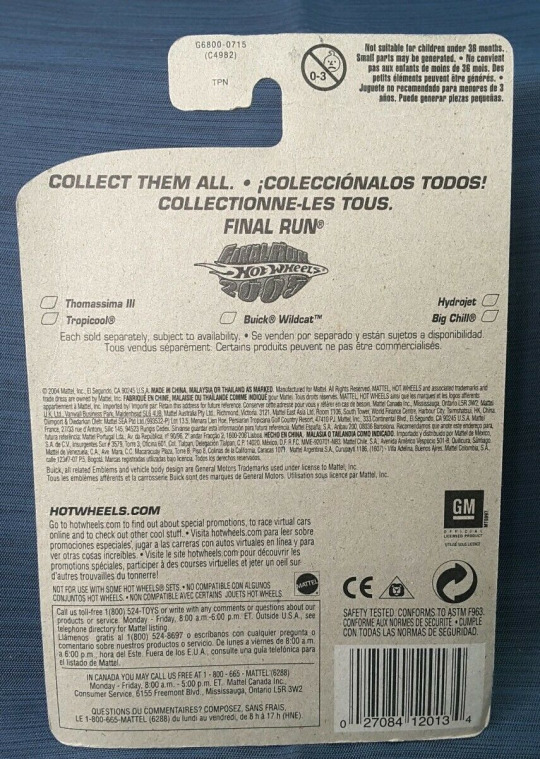
Of note is that the image above says that Tropicool (Good Humor Truck) is one of the castings that was intended to be Final Run; the actual casting that was Final Run was the Treadator, while Tropicool remains in the lineup to this day.

Always on the receiving end of very loud decals due to the large amount of space on the car, perfect for tampos, the Wildcat will be dearly missed (by me, at least) in the Hot Wheels lineup, and I wouldn’t mind seeing a modern recreation of the Wildcat return to the Hot Wheels lineup as a premium piece.
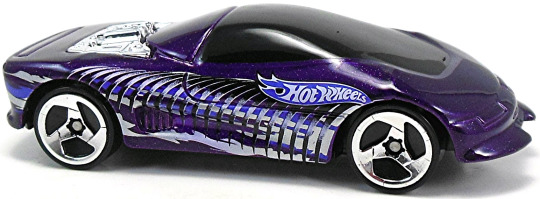
I hope this post has given you a better idea on the history of this futuristic American supercar, and the history of its small Hot Wheels counterpart. As usual, I’d write something like this any day.
1 note
·
View note
Photo

That Time Forgot: GM Lean Machine
When we think about GM concepts, what do you think of? We have the GM LeSabre, the GM UltraLite... GM Lean Machine... hang on, GM Lean Machine? If you’ve never heard of it, that’s okay, because today we’re going to talk about it, in today’s installment of That Time Forgot.
Imagine being in a packed highway with a massive traffic jam. You look around you and discover that most of the cars have only one occupant in them and are much bigger than they need to be, considering that they only have one occupant in them: the driver. You’re also wasting a bit of fuel as well while waiting in this jam. You want a car that consumes less fuel and is big enough to seat a driver.

Enter the GM Lean Machine. The solution to personal mobility thirty years before the competition, the vehicle was described as “it may be the first new road vehicle invented this century”. Developed by a man named Frank Winchell, the design process of the Lean Machine took about seven years, with work beginning after the gas shortage of the early 1970s.

Powered by a 185cc Honda 2-cylinder engine through a Peerless tractor differential producing 15 horsepower driving the rear wheels, the single-seat Lean Machine was able to tilt through the use of pedals. These pedals were located in a similar place as a car’s pedals were; these were attached to cables which wrapped around the spine of the rear chassis. Pushing one of the pedals unwraps the cable and rotates the cabin away from the pedal, leaning the body away from the direction of the pressed pedal. Additionally, a Y-shaped tube held a steering head of a fork with a vertical extension holding a spherical bearing rod end, which was bolted to the end of the spine of the rear chassis; the chassis was also connected to the spine via a sleeve bearing at the rear of the seat. Those two bearings work in tandem as well for the tilting action to occur. The engine was started through a pull-start cable accessed through a hatch in the mobile motor cover.

As you can see from the photo above, the Lean Machine was small. The vehicle had a wheelbase of just 71 inches (180 cm) and featured a front tire from a bike and rear tires from a boat trailer; Showa forks were used to support the front bike tire. Other specifications are detailed below. To stop the vehicle, the passenger pod was to be put back upright and held there with the legs and then a lever engaged to keep the body upright. The car was supposed to be a single-seat car, although a second tandem seat could be easily added.

A total of three Lean Machines were built. The car was first showcased in 1982, a few months after Winchell’s retirement from GM, although he did appear in multiple interviews talking about his creation. One of the Lean Machines ended up at the now-closed Epcot attraction World Of Motion; it could theoretically hit 200 mpg, which would be an impressive number... if it could actually run. This non-running prototype can be identified by its unique bullet-like appearance with a narrow Kamm tail and dual contoured protruding side pods covering the rear wheels. The Epcot Lean Machine had a drag coefficient of 0.15.

The Lean Machine got its big break in 1993 when it appeared in the film Demolition Man, alongside some seventeen other GM concept vehicles. One of the two Lean Machines was used in this film, where it was briefly driven by Simon Phoenix (Wesley Snipes).

The third Lean Machine was presumably stored away after development was done. A small scale orange model of the Lean Machine was also built, although this time it was engineered as a flying car, but... really?

Unsurprisingly the idea never took off (pun intended) and the cars were subsequently stored. The Lean Machine was apparently recently seen at the Petersen Automotive Museum’s recently finished exhibition titled Hollywood Dream Machines: Vehicles Of Science Fiction And Fantasy, however I have been unable to find any pictures of the Lean Machine at that exhibition. The car has since returned to the GM Heritage Center, where I believe all the Lean Machines currently are.
Okay, now that I’ve gotten that out of the way, let’s talk about the reason why you’re here: the history of the casting.

This casting was introduced in 1993 in the Demolition Man series, alongside eight other cars that appeared in the movie: these were the Oldsmobile Aurora, Olds 442 W-30, GM Ultralite, Corvette Stingray III, Pontiac Salsa, Pontiac Banshee, Buick Wildcat and the Chevrolet ACC Camaro (’93 Camaro), intended to represent the Chevrolet California IROC Camaro Concept. The designer of this casting is not known with any certainty, although I suspect it was done by Larry Wood.

This casting has a metal base and body, giving it some substantial weight. It has a rather interesting two-piece body, where the “top portion” of the body is riveted onto the bottom portion with the fenders.

Early versions will say "WARNER ‘93” instead of “MATTEL INC 1993”; I presume the license with Warner Bros. had expired, so they just scrubbed off the Warner licensing information and put their own on.

The canopy of this casting can be removed to reveal a metal seat, as well as the two-piece construction. This canopy was often made of opaque black plastic and could not be seen through, but certain versions had see-through canopies.

The Alien enjoyed the privilege of being released quite often when it was in the lineup, but ultimately this casting was doomed in 2003 for one reason, and one reason only: the Final Run Series. For four years, this casting had not been seen, and then it was thrown into the Final Run series.

The Final Run Series started in 1999 and acted as what I would consider a very glorified funeral for a casting; Hot Wheels would give these cars special tires and paint, in exchange for vowing to never produce them again by cutting their toolings in half. The Lean Machine was unfortunately one of the castings to fall victim to the Final Run Series, and although it might not have been one of the more popular castings to retire that year, it was still retired regardless. As the fourth batch of cars to be Final Run, having been introduced in the 2003 series, the Alien will never be seen again in the Hot Wheels lineup unless a new tool and die is created for it, which I believe is highly unlikely. The Final Run Series itself has been on hiatus since 2006. In total, the Lean Machine had fifteen releases.

Always on the receiving end of very loud decals due to the large amount of space on the sides of the car, perfect for tampos, the Lean Machine will be dearly missed (by me, at least) in the Hot Wheels lineup, and I wouldn’t mind seeing a modern recreation of the Lean Machine return to the Hot Wheels lineup as a premium piece.

I hope this post has given you a better idea on the history of “probably the first new vehicle of the 21st century”, and the history of its small Hot Wheels counterpart. As usual, I’d write something like this any day.
- Grunty
1 note
·
View note
Photo

That Time Forgot: GM Ultralite
I kind of like this new life of mine, being able to pursue my own interests and stuff. However, I feel it is a disservice to keep this blog inactive, hence why I’ve decided to put this post up to show that this blog is not dead. Anyway, enough talk about this, and let’s talk about what you’re really here for: to talk about this car.
“100 mpg in the ‘90s? Impossible.” Is what many people will say... but they’ve definitely not seen this car before. Let’s talk about that.

This is the General Motors Ultralite, a car from 1992 that still looks futuristic... even today. Designed by Burt Rutan, Jim Lutz, Steve Small, Bill Rohlfing and Jim Bieck, the Ultralite was designed as a four-seat car that could comfortably carry all four passengers, have adequate performance and produce low emissions and astonishingly high miles per gallon.

First introduced at the 1992 Chicago Auto Show, the Ultralite was not just your normal concept car; it was actually fully functional. But then again, pretty much all of GM’s concept cars of that time were functional. This car featured a RR layout; or for those who don’t know, rear-engined, rear-wheel drive. A ten-minute promotional video was also produced.

The body of the Ultralite was made of carbon fiber and built by Scaled Composites; the entire body only weighed 420 pounds (191 kg)! With the body on, the car weighed about 1400 pounds (635 kg).

Performance of the Ultralite was expected to match or better that of GM’s quintessential compact sedan, the Chevrolet Lumina. As the body itself was so light, the Ultralite didn’t need too big a power plant to power it. The rear-engined car was powered by a 1.5L inline-3 two-stroke engine producing 111 horsepower, mated to a Saturn 4-speed automatic transmission; GM claimed top speeds of up to 135 mph (217 km/h). It also had a claimed 0-60 time of about 8 seconds, which, if you think about it, is pretty darned good for an engine of this size...

The Ultralite’s engine was placed in the rear in what was termed a “power pod” configuration, which was basically GM’s term for “removable engine”; this reminds me of the IAD Alien which had a very similar concept. This “power pod” had a number of advantages, including easier service and the added modularity of fitting different types of power plants.

The shape of the Ultralite was highly reminiscent of that of the older Ford Probe concepts designed by Ghia.

The interior looked somewhat futuristic and honestly quite nice, but the best part of the Ultralite’s appearance... were those doors.

Yep, that’s right; the Ultralite sported gullwing doors. It also... had no B-pillar.

Regardless, the Ultralite was probably one of the most futuristic cars ever conceived. Featuring fiber-optic headlamps and LED taillamps, the car also featured an airbag suspension on all four wheels, allowing it to ride high or low depending on what speed the car was going at. It also had an astonishingly low drag coefficient of 0.19, far lower than most cars of the time.

While the doors were (and still are) quite impressive, quite possibly one of the most impressive things about the Ultralite was its fuel economy. The car (being fully functional) was actually tested and rated by the EPA, clocking in a staggering 88 mpg; GM claimed the car could clock in 100 mpg if the car was driven at a sustained 50 mph (80 km/h) cruise.

GM did consider putting the Ultralite into production, although with a body made of carbon fiber it would have never been affordable. Additionally, with California’s zero-emission vehicle mandate looming, GM made a decision to scrap the Ultralite and produce the EV1 (above) instead. And we all know how that went...

However, not all was lost. Now, with the introduction of ever-tighter Corporate Average Fuel Economy standards, carbon fiber has become almost mainstream and smaller and smaller engines have become the norm to meet these strict standards, something the Ultralite was able to achieve... twenty years before the competition.

A total of two Ultralites were produced. Normally, I believe they sit amongst a sea of other innovative cars at the GM Heritage Center, but one Ultralite currently sits proudly amongst a sea of iconic movie cars in the Hollywood Dream Machines: Vehicles of Science Fiction and Fantasy exhibition at the Petersen Automotive Museum. Oh, speaking of movies... we’ll get to that bit now.

Due to its unique and futuristic shape, the Ultralite has been used in various science fiction movie productions, usually representing a car of the future. It had a number of big breaks in a number of science fiction films, all of which will be detailed below.

The most notable of the Ultralite’s appearances was in 1993, when it appeared in the film Demolition Man, alongside some seventeen other GM concept vehicles. Representing a 2042 Chevrolet police vehicle, this Ultralite was driven throughout the film and played a highly prominent role.

Twenty fiberglass replicas of the Ultralite were produced, which were used throughout the film as either police cars or civilian cars, recognizable by whether they have the “siren dome” or not; civilian Ultralites usually played minor background roles. There exists a rather grainy picture showing three of these replicas. Whether the two actual carbon fiber Ultralites took part in the filming is unclear, although it seems unlikely.

The Ultralite was seen again in the old television series seaQuest DSV, albeit only very briefly, in the episode The Fear That Follows which aired in 1994.

The Ultralite was seen again in the 1999 film Bicentennial Man starring Robin Williams, although again very briefly. Sure, it’s a cool car that’s in the movie, but there’s probably other reasons as to why people don’t remember this film...

Finally, a police Ultralite appeared in the movie A.I. Artificial Intelligence starring Haley Joel Osment. This was the last of its known appearances... well, according to IMCDb anyway.

It also appears that at least one of these fiberglass replicas was auctioned off by Warner Bros. around 2012, although with some generic police livery; as you can see, it looks pretty worse for wear...
Okay, now that I’ve gotten that out of the way, let’s talk about the reason why you’re here: the history of the casting.

This casting was introduced in 1993 in the Demolition Man series, alongside eight other cars that appeared in the movie: these were the Oldsmobile Aurora, Olds 442 W-30, GM Lean Machine, Corvette Stingray III, Pontiac Salsa, Pontiac Banshee, Buick Wildcat and the Chevrolet ACC Camaro (’93 Camaro), intended to represent the Chevrolet California IROC Camaro Concept. The designer of this casting is not known with any certainty, although I suspect it was done by Larry Wood. The Hot Wheels version of the Ultralite depicts the famous police Ultralite as seen in the movie, as evidenced by the siren dome up top.

Like all other Demolition Man castings, the Ultralite was packaged in a box containing a Cryo-Cube (essentially a Park’n Plates box with a picture of the real car instead of a license plate). The windshields and doors of this casting are molded into the body, and as such, are completely opaque; as a result, this car has no interior.

The rear replicates the rear of the real car somewhat well, although the wing up top seems a bit high and the rear “vent” seems a little bit too big as well compared to the real car.

A picture of the real Ultralite’s rear is shown above.

Early versions will say "‘93 WARNER” instead of “1993 MATTEL, INC”; I presume the license with Warner Bros. had expired, so they just scrubbed off the Warner licensing information and put their own on. Something else interesting to note is that this casting has a practically centered center of gravity; as it has a plastic base, this casting would be thought to be quite light, but it is in no way light. As the body is one huge hunk of metal (again, the windows are opaque), the Ultralite is supremely heavy, with all the weight concentrated around the center of the car. This theoretically makes the car better for downhill races, although I would seriously doubt the car’s ability to clear a loop.

The Ultralite enjoyed various releases in the Hot Wheels lineup, most of which having the SAPD-style police livery on it, whether it be with or without SAPD graphics.

This casting was also given the generic name “Police Car” for one of its releases.

Another release simply titled it “Police”, although I believe this is an international only release and doesn’t seem to be documented all that well. Both “Police Car” and “Police” would be used on future releases of the Holden Police Cruiser Hot Wheels released in 1996.

The Ultralite enjoyed the privilege of being released quite often when it was in the lineup, but ultimately this casting was doomed in 2001 for one reason, and one reason only: the Final Run Series. For three years, this casting had not been seen, and then it was thrown into the Final Run series.

The Final Run Series started in 1999 and acted as what I would consider a very glorified funeral for a casting; Hot Wheels would give these cars special tires and paint, in exchange for vowing to never produce them again by cutting their toolings in half. The Ultralite was unfortunately one of the castings to fall victim to the Final Run Series, and although it might not have been one of the more popular castings to retire that year, it was still retired regardless. As the second batch of cars to be Final Run, having been introduced in the 2001 series, the Ultralite will never be seen again in the Hot Wheels lineup unless a new tool and die is created for it, which I believe is highly unlikely. The Final Run Series itself has been on hiatus since 2006. In total, the Ultralite had seven releases.

Of note is that the image above has some interesting details. The Ultralite was released simply as the “Ultralite” in the Final Run series, but its full name is spelled out in the rear of these cards. “Garbage Truck” refers to the Recycling Truck, but it gets a pass since the casting was actually titled that for release. “Porsche 911” refers to the P-911 casting, but that gets a pass for the same reason. And finally, “Scullrider” refers to the Skullrider (or Grim Creeper) casting; this is simply a spelling error and the casting received the correct spelling on the actual production card.

Always on the receiving end of police-styled decals due to its fame in Demolition Man, the Ultralite will be dearly missed (by me, at least) in the Hot Wheels lineup, and I wouldn’t mind seeing a modern recreation of the Ultralite return to the Hot Wheels lineup as a premium piece.

I hope this post has given you a better idea on the history of this futuristic GM concept car, and the history of its small Hot Wheels counterpart. As usual, I’d write something like this any day.
1 note
·
View note
Photo

Grunty’s Goodbye: 1996 Mustang GT
Sometimes, castings retire for one reason or another. There’s reasons such as lost toolings to other reasons such as licensing issues. This time, we’ll talk about one that was retired... just because it had to be. This... is the 1996 Ford Mustang GT.

Designed by Patrick Schiavone, Emeline King and Bud Magaldi with a facelift done by Doug Gaffka, the fourth generation Mustang was produced from 1994 to 2004. This was the first major redesign of the Ford Mustang’s platform in 15 years. Internally designated the SN-95, the Mustang was based on an updated version of Ford’s Fox platform, and was the very last vehicle to be produced on said platform. The 1996 Ford Mustang GT was fitted with the now-ubiquitous 4.6L Ford Modular V8, being the first car to use the 4.6L engine; it also featured stiffer suspension, dual exhausts and larger 16 inch (41 cm) wheels. Of the 135,620 Mustangs produced for 1996, 17,917 were convertibles.
Okay, now that we’ve gotten the abridged history of the ‘96 Mustang GT out of the way, let’s get to the real reason why you’re here.

The 1996 Mustang GT was designed by a man you may have heard about, although I feel he is quite possibly one of the least known Hot Wheels designers: Michael Kolins.
Michael Kolins is one of the designers where information on him is very difficult to find. However, what is known is that he designed from about 1996 until the early 2000s. Some of the castings he designed include:
• 1970 Dodge Charger Daytona (1996 New Models, 1996 – 2003, retired) • Ferrari 360 Modena (1999 First Editions, 1999 – 2010) • Ferrari 365 GTB/4 (2000 First Editions, 2000 – 2011) • Ferrari F50 Challenge (1999 First Editions, 1999 – 2013) • Ford F-150 (1997 First Editions, 1997 – Present) • GP-2009 (1999 Pro Racing, 1999 – 2016) • 1999 Isuzu VehiCross (2000 First Editions, 2000 – 2004) • '64 Lincoln Continental (2000 First Editions, 2000 – 2013) • Lotus Elise 340R (2000 First Editions, 2000 – 2009)
This casting was introduced in 1996 as a First Edition in the red paintscheme as shown above, alongside eleven other models, including the 1970 Dodge Charger Daytona (also designed by Kolins), Rail Rodder, Volkswagen Drag Bus and the Road Rocket.

This casting is quite heavy, for it has a metal base.

The rear of the casting also features a high level of detail not present on most cars of the period, featuring the Hot Wheels logo on the wing and “MUSTANG GT” tampoed onto the rear bumper.

As with most Michael Kolins castings, the interior detail of this casting is outstanding, with fully-detailed seats and a nicely molded shifter lever.

This casting is most often seen as a convertible, however, there have been two releases where this casting is retooled to become a hardtop; the hardtop is actually a simple plastic insert colored in certain places to make the appearance of a “convincing” roof. This version was only released in FAO Schwartz boxed sets.

The 1996 Mustang GT enjoyed the privilege of being released quite often when it was in the lineup, but ultimately this casting was doomed in 2003 for one reason, and one reason only: the Final Run Series.

The Final Run Series started in 1999 and acted as what I would consider a very glorified funeral for a casting; Hot Wheels would give these cars special tires and paint, in exchange for vowing to never produce them again by cutting their toolings in half. The 1996 Mustang GT was unfortunately one of the castings to fall victim to the Final Run Series; in my opinion, this was likely one of the most popular castings to fall victim to the cutter’s torch. As the fourth batch of cars to be Final Run, having been introduced in the 2003 series, the 1996 Mustang GT will never be seen again in the Hot Wheels lineup unless a new tool and die is created for it, which I believe is highly unlikely. The Final Run Series itself has been on hiatus since 2006. In total, the Alien had twenty-eight releases, including both hardtop versions.

The casting was intended to be Final Run first in 2002 along with the above few castings; however, the series was not released as intended, with only three cars (Porsche 928, Oshkosh Cement Mixer/Spin-Out and the Firebird Funny Car) being released. The casting was then thrown into the 2003 Final Run Series with the 9 unreleased cars from that series, along with three other new cars: Porsche 911 Carrera, Auburn 852 and the GM Lean Machine. I’ll cover the GM Lean Machine in a separate post.

With large slabbed sides and often receiving silver headlamps, the 1996 Ford Mustang GT was often one of the most detailed castings of the time. It will be dearly missed by me (and probably others) and I hope Hot Wheels will do a recreation of a SN-95 Mustang convertible in the near future.

I hope this post has given you a better idea on this pony car’s small Hot Wheels counterpart. As usual, I’d write something like this any day.
- Grunty
1 note
·
View note